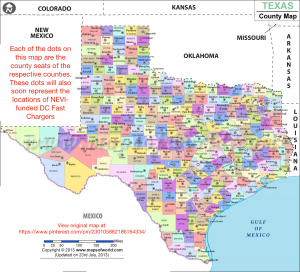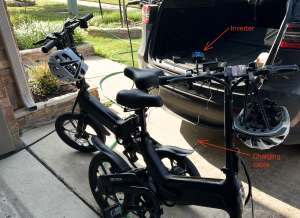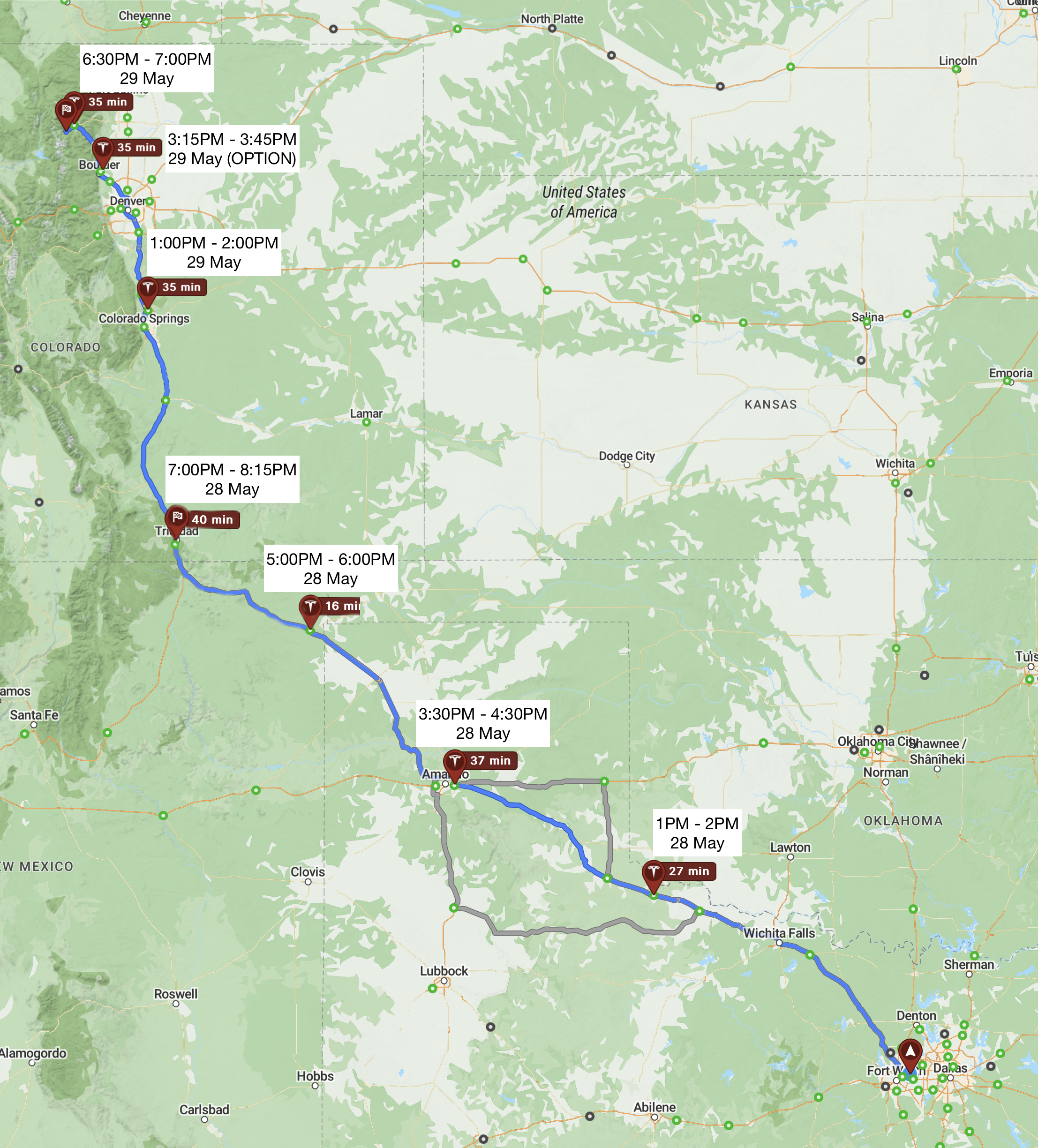This year, in my work with TxETRA, I’ve participated in two of our Education Fund‘s EV Road Trips. One trip was to East Texas, during which I drove 902 miles, over 4 days. During the South Texas EV Road Trip, I drove 1,329 miles, over 4 days. I also drove 799 miles around Texas to participate in the Bayou City Electric School Bus Festival and to look for a place to view this year’s total eclipse. On top of that, I’ve taken many day trips to Austin for my TxETRA work, averaging around 400 miles per day. My comfort zone has extended dramatically, since our very first road trip in our new EV, which was just a day trip of 250 miles.
That’s a lot of numbers to absorb, but here’s why I mention all that: My wife and I are about to take a vacation to Rocky Mountain National Park. We’ll drive (and camp!) in our EV at Glacier Basin campground. The round trip will measure 1,684 miles, plus whatever driving we do around the park. Usually, for trips longer than this one, we’d just book a flight. This will be the longest road trip I’ve ever taken in a plug-in vehicle other than a trip I took in 2013, to the Chicago Auto Show, in my 2012 Chevrolet Volt plug-in hybrid electric vehicle (PHEV).
I’m sharing this trip with you to show how relatively easy it is to vacation in an EV and how it’s about to get much easier.
I started planning the route, using A Better Route Planner. ABRP is an indispensable tool for planning long EV road trips. A also use PlugShare as an additional reference, as it includes reviews and other tidbits about the chargers from fellow EV drivers.
The map above shows where we’ll stop to charge on the two day drive to the park. I’ve added the approximate times we’ll be at each of the charging sites to the map. The times were added for two reasons: 1) If you’re near one of the charging locations at the time I’ll be there, I’d like to meet you in person and 2) to show that charging doesn’t have to make a road trip take longer than in an internal combustion engine (ICE) equipped vehicle.
Notice that I’ll be stopping in Childress, Texas at 1PM and in Trinidad, Colorado at 7PM. While our EV is charging, we’ll be having lunch and dinner. During the EV road trips mentioned above, I noticed that our EV was usually finished charging before I finished eating my meal. I would have stopped to eat, even if in driving an ICE vehicle, so charging at those locations made no difference in drive time.Between Childress and Trinidad, we’ll stop in Amarillo, Texas and Clayton, New Mexico to charge, adding 53 minutes to our drive time (more on that later…).
We will spend the night in Trinidad. I usually select a hotel that has free Level 2 charging. Level 2 charging is much slower than DC fast charging, but if you’re asleep at the hotel, who cares? On this trip, we are staying at a hotel that doesn’t have charging. It is a lower cost hotel but we are still getting free charging from Tesla. The charging is free because our Model Y is less than six months old. (I’m frugal, not cheap.)
The next morning, we’ll stop for lunch+charging in Colorado Springs and for a beverage+charging with friends in Boulder. Neither of these stops is necessary, from a charging standpoint. The drive from Trinidad to Estes Park is 261 miles and our Model Y is the “Long Range” version with 320 miles of range. We’ll charge to 90% in Trinidad, so we could make the drive without stopping. But, since we have to eat and want to hang out with friends, we’ll do what’s called “opportunity charging” in EV vernacular.
But wait! There’s More!
The state of Texas has already started installing DC fast chargers (DCFC), using the National Electric Vehicle Infrastructure (NEVI) program. Phase one of the Texas rollout will install DCFC every 50 miles along our interstate highways. After that, the program moves to rural areas with DCFCs planned for every county in the state, probably located in the county seat of each county.

The state of Texas has already started installing DC fast chargers (DCFC), using the National Electric Vehicle Infrastructure (NEVI) program. Phase one of the Texas rollout will install DCFC every 50 miles along our interstate highways. After that, the program moves to rural areas with DCFCs planned for every county in the state, probably located in the county seat of each county. (click on the map, to the left, for a larger version with the county seats marked)
During the TxETRA EV Road Trips, we were accompanied by Michael Chamberlain of the Texas Department of Transportation. Michael gave a presentation to the local chambers of commerce, regarding the NEVI program in Texas. You can watch his presentation below:
If the Texas NEVI plan had already installed DCFCs in every county, my route to Estes Park would have been changed. We would have driven past Childress without charging, opting to charge and have lunch in Clarendon, TX instead. This change to our route would eliminate the need to charge in Amarillo or Clayton, NM. Instead, we’d charge and have dinner in Raton, NM, much closer to Colorado. From Raton, we would not have to charge again before arriving in Estes Park, but could charge overnight, if we decided to include a hotel stay along the route. In other words, once Texas has DCFCs in every county seat, our trip to Colorado would only require two stops along the route. That’s about the same as an ICE vehicle, but the charging would not add time to the drive, since both charge sessions would be during a meal stop.
The future’s so bright we gotta wear shades!

We are taking three EVs on this trip: our Tesla Model Y and two Jetson Haze folding electric bikes. We already have two full-sized eBikes, but they were going to be too cumbersome to carry with us. We opted for folding eBikes so we could store them inside the car, avoiding wind drag and possible range loss for our EV.
We also bought an inverter from Amazon that allows our Tesla to recharge our eBikes, so we’ll be able to charge them at our campsite instead of running into town every time we need to recharge. What a time we live in!

(In the image to the left, one of the eBikes is being charged.)
Being frugal, we bought the eBikes from Costco and saved hundreds of dollars. In fact, the in-store price is even lower than the price on the Costco website! An additional benefit of Costco membership is that, from time to time, members qualify for a discount on new EVs at participating dealerships. So, if you’re in the market for a new EV, ask your dealer about the “Costco incentive.”
We also got several Tesla-oriented pieces of camping gear for this first camping trip:
- Lost Horizon air/memory foam mattress for Model Y, (awesome mattress)
- ThinSGO Sunroof Sunshade for Tesla Model Y,
- TESBEAUTY Camping Privacy Curtains especially designed for Tesla Model Y.
Have I mentioned I’m frugal?
I hope to post updates from the road, during the trip. Keep an eye on my Facebook page, YouTube channel and Instagram to see how it’s progressing.


